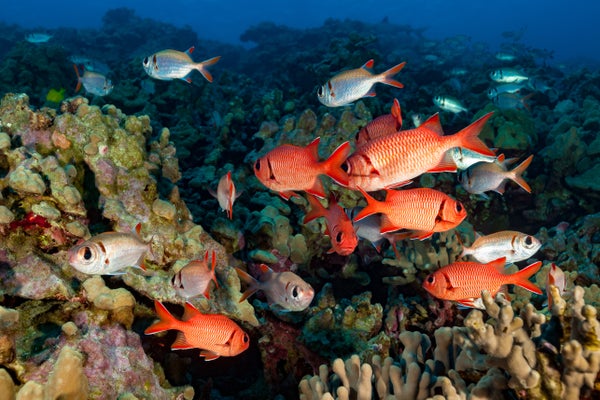CLIMATEWIRE | A niche financial tool is making it easier to repair critical ecosystems after natural disasters — and protect at-risk communities from future extreme weather.
The Nature Conservancy announced this week that it has expanded its parametric insurance policy for Hawaii's coral reefs, guaranteeing a sizable payout if a storm of a certain caliber hits nearby. The idea is now gaining steam in other parts of the world, from Fiji to Mexico.
In Hawaii, the funds would be used to remove debris and reattach broken pieces of coral. The ultimate goal: the long-term preservation of the reefs, which not only carry immense biological, cultural and economic value — but also help protect Hawaiian communities from climate-juiced storms.
On supporting science journalism
If you're enjoying this article, consider supporting our award-winning journalism by subscribing. By purchasing a subscription you are helping to ensure the future of impactful stories about the discoveries and ideas shaping our world today.
“The value of the coral reefs to somewhere like Hawaii is absolutely huge,” said Simon Young of insurance brokerage firm WTW, which created the policy with TNC. “They basically act as a natural sea wall and greatly mitigate the impacts of waves on the coastline” while also supporting the tourism and fishing industries.
WTW and The Nature Conservancy billed the new policy as a “major upgrade” to a previous version launched in 2022, which expired in 2023. The new policy, which TNC purchased from Munich Re Group using $106,000 in donations, covers an additional 314,000 square miles and doubles the minimum payout TNC will receive if the covered area sees tropical storm winds above a certain intensity.
If a storm hits that is 50 knots or greater, for instance, TNC would receive a minimum of $200,000, which it would then distribute to partner organizations charged with repairing the damage. If Hawaii saw a much stronger storm, TNC could see a payout as high as $1 million.
Proponents of the effort say the policy is significant in its own right. But they also argue its indicative of a growing appetite for — and interest in — parametric insurance that could be used to protect ecosystems such as reefs and mangroves amid rising temperatures.
The first policy of this kind was launched in 2019, which means the model is far from mainstream. TNC and other groups are thus educating potential policyholders about the option, with the hope that eventually communities or state organizations would pay the premiums, perhaps with contributions from the private sector.
“The concept we do think is widely transferable, but more people need to be aware that it exists,” Eric Roberts, TNC’s senior manager of climate risk and resilience, said in an interview. “People don’t recognize yet that natural resources like coral reefs or mangroves can actually provide these risk reduction benefits.”
Roberts said the Hawaii policy is among a growing list of similar policies that aim to not only protect natural resources in climate-vulnerable areas but also prove that parametric insurance for ecosystems is a worthwhile investment. Each policy is different, tweaked to suit the country and environment.
Earlier this month, for instance, WTW unveiled a different coral reef insurance policy in Fiji that offers local communities payouts up to $450,000 in the case of a future cyclone. Those dollars would go to reef restoration, as well as help ensure locals have access to food and water following disasters.
In December, insurer AXA Climate launched the first-ever parametric policy for mangroves on the Yucatan Peninsula after hurricanes. The mangroves serve as powerful carbon sinks and a key source of income for local communities.
Other policies have been around for longer — and resulted in payouts. The first such policy, launched in 2019 with the help of TNC, covered hurricane damage to coral reefs in Quintana Roo, Mexico. After Hurricane Delta hit the region in 2020, the policy paid $850,000 for reef restoration.
Another policy, backed by WTW, targets the Mesoamerican Reef, which stretches from southern Mexico through Belize, Guatemala and Honduras. Hurricane Lisa in 2022 triggered that policy, resulting in a $175,000 payout for beach and reef repair.
Other policies are still are being explored or actively developed across the world. The Asian Development Bank, for instance, has set aside millions of dollars to explore climate risk financing and insurance products to protect reefs in Fiji, Indonesia, the Philippines and the Solomon Islands.
And TNC already has a reef insurance feasibility project underway in the Bahamas — and is gauging interest in the Caribbean and near the Great Barrier Reef.
The overall goal is to “create a road map to demystify the process, to demonstrate the value,” said Eric Conklin, TNC’s Hawaii marine science director. “The easier we make that, the better chance of getting broader adoption and more areas protected with this kind of mechanism.”
Reprinted from E&E News with permission from POLITICO, LLC. Copyright 2023. E&E News provides essential news for energy and environment professionals.
